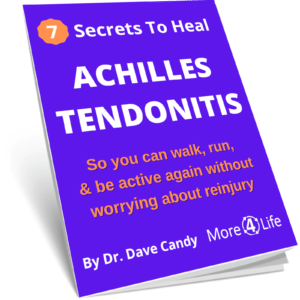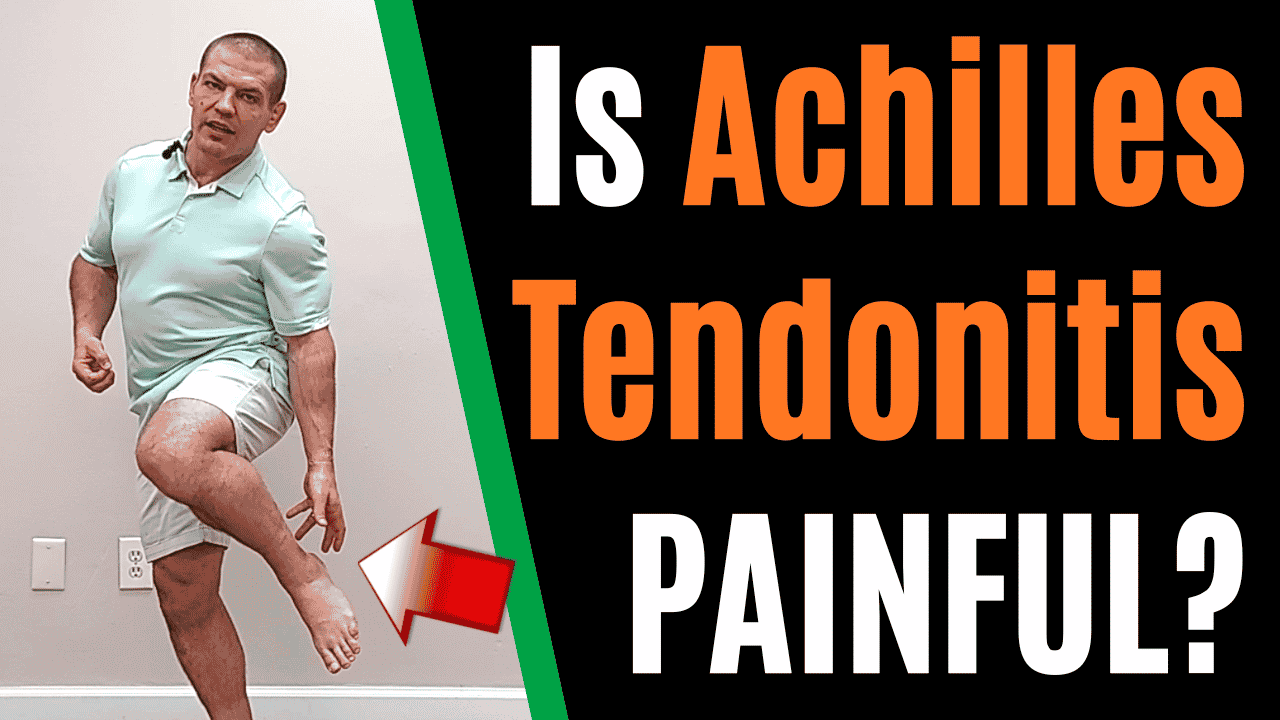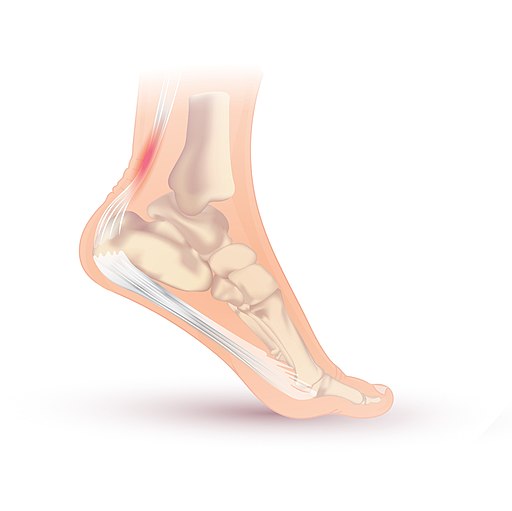Many runners and other people who experience an ache around their Achilles tendon may suspect that they have Achilles tendonitis and wonder:
Is Achilles tendonitis painful?
The answer might surprise you. Watch the video to learn more...

Is Achilles Tendonitis Painful?
First of all, let's get some terminology straight:
Achilles tendonitis means "inflammation of the Achilles tendon" with the term "-itis" meaning inflammation.
However, most people who suspect that they have Achilles tendonitis actually have "Achilles tendinopathy" or "Achilles tendinosis"
Achilles tendinopathy means "a pathological condition of the Achilles tendon"
meaning an "abnormal condition of the Achilles tendon" which most of the time is not inflammatory.
The hallmark signs of inflammation are:
- Redness
- Warmth
- Pain
- Swelling
- Loss of Function
This means that by definition, true Achilles tendinitis is painful.
This type of Achilles tendinitis would come from an acute injury such as when suddenly pushing of to sprint or change directions rapidly. You'd probably feel pain immediately at the moment of injury.
However, the type of Achilles tendon disorder that MOST people experience, Achilles Tendinopathy, often is NOT painful.
Most people experience Achilles tendinopathy as a dull ache in the calf or Achilles tendon, but it isn't painful.
Usually you CAN continue to exercise with Achilles tendinopathy and pain may not start until later in the activity (such as toward the end of a run or long walk). Alternatively, Achilles tendinopathy may not be painful until AFTER activity.
Because athletes can often put up with the discomfort of exercise with Achilles tendinopathy, they often don't stop exercising until the problem either gets worse, or in the worst case scenario, causes an Achilles tendon rupture.
Why Is Achilles Tendonitis Painful?
Achilles tendonitis is painful because after an acute injury because inflammatory chemicals get released from the injured tendon fibers. These chemicals start a chain reaction of healing responses to heal the tissue.
These responses include:
- Swelling: Swelling comes from fluid released from injured blood and lymph vessels after a tissue injury. The fluid partially splints and protects the area as well as contains chemicals that start further reactions.
- Pain: Inflammatory chemicals such as substance P, bradykinin, and lactic acid stimulate free nerve endings in the area of the tendon. These free nerve endings send messages to your spinal cord to tell your brain about the injury. In response, your brain produces an unpleasant sensation that we call PAIN, which makes you not want to move or use your Achilles tendon any further. This painful response to acute Achilles tendonitis is a GOOD thing, because it protects the tendon from further injury.
- Cellular response: The inflammatory chemicals released during Achilles tendonitis signal certain types of cells to come to the area. Some of these cells (macrophages) are responsible for cleaning up the old injured tissue. Other cells (fibroblasts) are responsible for laying down new, healthy tendon tissue.
Why Is Achilles Tendinopathy NOT Always Painful?
Achilles tendinopathy is not always painful because the inflammatory process has either stopped or was never started. Repetitive strain injuries such as running with improper running mechanics or poorly fit running shoes can cause micro-injuries to the tendon over time. This means the Achilles tendon can get injured, but not be painful.
Why Is Achilles Tendinopathy Sometimes Painful?
When repetitive strain injury has gone on a long time, trigger points, or "knots", can develop in the calf muscles. These trigger points can restrict blood flow to the calf muscles and Achilles tendon causing ischemia, or lack of oxygen, to the tendon. This creates a local energy crisis in the area of the tendon.
An Achilles Tendon Without Oxygen Is Painful
A lack of oxygen makes it difficult for your muscles and tendons to produce the energy they need during levels of high activity.
Under normal circumstances, your muscles use oxygen to turn glucose into ATP, which your body uses to produce energy using a process called oxidative phosphorylation.
When oxygen isn't available, you can still create ATP, but the process is only 1/16th as efficient and it creates bi-products such as lactic acid.
Lactic acid buildup in your tissues is what makes you "feel the burn" when you're exercising, and it can also trigger free nerve endings.
Thus when you exercise at a high intensity for a long period of time, the lactic acid buildup can stimulate free nerve endings and cause a painful response, even though your
Achilles tendon isn't injured.
The problem with this type of pain though is that it isn't helpful like in the case of acute Achilles tendonitis.
The pain in acute Achilles tendonitis tells you not to move, and for good reason.
The pain in chronic / overuse Achilles tendinopathy tells you not to move, but NOT moving actually makes the problem worse.
Again, that's because painful Achilles tendinopathy is an ischemic injury - meaning lacking oxygen. That can be likened to a transient ischemic attack (TIA - a "mini-stroke") or myocardial ischemia (angina).
If you live a very sedentary life, whether it's due to your Achilles pain or not, you can end up "training" your heart to have to work harder to supply your body with oxygen.
When you work the heart muscle too hard and it's not getting enough oxygen, it creates angina (chest pain), and eventually a mini-stroke.
But what's the best treatment for heart disease?
Well, diet is certainly part of the equation, but you also need to do low-intensity aerobic exercise to recondition your heart muscle.
The same is true with painful Achilles tendinopathy
Working the calf muscle and Achilles tendon too hard will cause symptoms.
Rest will alleviate symptoms in the short term, but in the long term, if you rest TOO MUCH, then your calf muscles get more poorly conditioned, making it take LESS activity to cause symptoms the next time you exercise.
Ignoring Painful Achilles Tendinopathy Is A Bad Idea
Just like ignoring angina or just stopping exercise all together can lead to a heart attack, ignoring painful Achilles tendinopathy can put you at risk for an Achilles Tendon rupture.
If you'd like some help for your Achilles tendon pain, click the button below to request an appointment with one of our specialists.
What's The Best Treatment For Achilles Tendonitis?
The best treatment for true Achilles Tendinitis is a short period of rest, followed by off-loading the tendon with a heel lift and then gradually resuming activity.
Again though, true Achilles tendonitis is rare.
So that begs the question:
What's The Best Treatment For Painful Achilles Tendinopathy?
The best treatment for painful Achilles tendinopathy still includes offloading the Achilles tendon with a heel lift, but instead of resting it, you want to start reconditioning the tendon right away.
In addition, treating the trigger points in the calf that are causing the lack of blood flow to the tendon can also help.
Ultimately, if you want a long-term solution to Achilles tendinopathy so you can resume your prior level of activity without flare-ups or risking an Achilles Tendon tear, you need to address the underlying issues that caused the trigger points in the first place.
These root causes usually include poor running mechanics, overtraining, or wearing bad shoes that are poorly fit or too worn down.
Most of the time, it's a combination of more than one of these causes.
Want To Discover The Cause Of Your Achilles Tendon Pain And How To Stop It?
Request a Free Discovery Visit with one of our physical therapists to learn how we can help.



